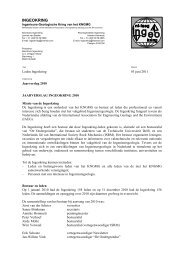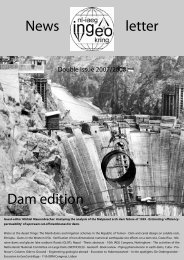environment
environment
environment
- No tags were found...
Create successful ePaper yourself
Turn your PDF publications into a flip-book with our unique Google optimized e-Paper software.
Ingeokring Newsletter<br />
THESIS ABSTRACTS<br />
Abstract thesis Jeroen<br />
van Nes<br />
TU Delft<br />
Application of computerized tomography to investigate<br />
strain fields caused by cone penetration in sands.<br />
Everywhere in the Netherlands, where a structure is<br />
built, a study of the shallow subsurface is done. It is of<br />
major importance to know the geotechnical properties<br />
of the soils on which the structure is to be founded.<br />
One of the most important methods to explore the<br />
subsurface is the cone penetration test (CPT).<br />
A large number of correlations between cone penetration<br />
test parameters and several geotechnical soil properties<br />
exist but have a low degree of repeatability. Empirical<br />
relationships require local tuning. Analytical<br />
relationships make strong assumptions on failure<br />
structures, which are believed to be created by the CPT<br />
test but have not been really investigated. Numerical<br />
codes have problems in simulating cone penetration<br />
correctly and their results are only partially validated<br />
with cone resistance measurements.<br />
The objective of this thesis is to visualize and<br />
characterize the deformation patterns taking place during<br />
cone penetration using X-ray Computerized<br />
Tomography (CT). Its outcome can be used to improve<br />
hypotheses made in analytical models or validate new<br />
numerical models, either finite element models or discrete<br />
element models.<br />
For this purpose, homogenous dry sand samples of<br />
various densities are prepared with dry sand pluviation.<br />
Baskarp sand is selected due to the finesses, well sorting<br />
and small amount of contamination by deviate minerals<br />
and materials. Sand samples are created with a density<br />
varying between 1,51 g/cm3 and 1,68g/cm3. Small-scale<br />
penetration tests are conducted with a 6 mm diameter<br />
aluminium cone in calibration chambers with varying<br />
density, confining pressures and boundary properties.<br />
Measured cone penetration resistances range from 5<br />
MPa in loose sand under low confining pressure (40<br />
kPa) up to18 MPa in dense sand under high confining<br />
pressures (80 kPa). The measured lateral strains ranges<br />
from almost zero in loose sand, up to 0,0035 in dense<br />
sand. Taking in consideration the measurements of the<br />
cone penetration resistance and lateral strain<br />
measurements it can be concluded that the repeatability<br />
of the small scale CPT test is adequate.<br />
To investigate the deformation patterns and failure<br />
Spatial distribution of the absolute density of the<br />
initial sand sample (left) and penetrated sand sample<br />
(right). The horizontal lines in the sand sample are<br />
placed on purpose in order to obtain a better<br />
visualization of the deformation occurring during the<br />
CPT test.<br />
structures, computerized tomography, a nonedestructive<br />
investigation method, is used to analyse<br />
the sand sample before and at several stages during the<br />
CPT tests. By obtaining the linear relationship between<br />
the Hounsfield Values observed in the CT-analyses and<br />
the sand density it is possible to define the density<br />
changes and volumetric strain in the sand samples.<br />
Several scanning parameters are to be set before any<br />
CT-scanning can begin: the X-ray intensity X-ray beam<br />
strength and slice width. Also the diameter of the sample<br />
influences the image quality obtained by the CT-scanner.<br />
Several tests show that the optimum scanning<br />
parameters are a high X-ray intensity (to decrease noise),<br />
a moderate high X-ray beam strength (to decrease beamhardening<br />
effects and to keep the loss of beam<br />
sensitivity to a minimum), and a slice thickness of 1 mm<br />
(to obtain an adequate resolution in the direction<br />
perpendicular to the slices). The diameter of the sand<br />
samples used during this thesis study is 10 cm but it is<br />
also possible to use larger diameters up to 15 cm.<br />
In general the test results showed that a dilating area is<br />
formed ahead of the cone tip during the penetration,<br />
creating a dilating zone around the probe. A very dilating<br />
zone was found at 1-2 mm from the probe and shear<br />
bands are believed to be present in these zones. Outside<br />
this dilating area an area is observed which is not<br />
influenced or slightly compacted by the penetration test.<br />
In some cases some compaction takes place in front of<br />
62




